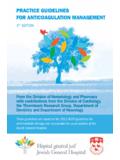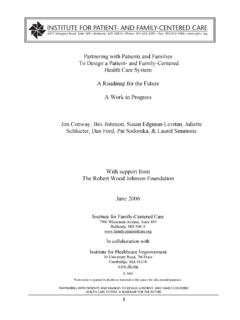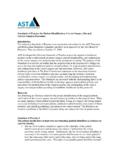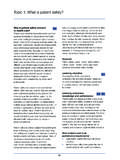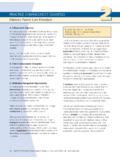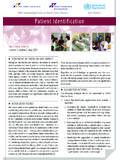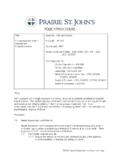Transcription of How to Create Effective Written Patient Learning …
1 How to Create Effective Written Patient Learning Materials Adapted by the JGH Patient education Network (PEN) Working Group from the McGIll University Health Centre Standards for Developing Effective Written Patient Learning Materials 2007. 2008. JGH HANDBOOK: HOW TO Create Effective Written Patient education MATERIALS PAGE 1. Acknowledgements This handbook was adapted with permission from: C. Oliver, J. Asselstine, Peterson, L. Rosati-White, L. Stephenson, the MUHC Patient education Network Committee, MUHC Standards for Developing Effective Written Patient Learning Materials, April 30, 2007 draft. We would like to thank the committee for their generosity in sharing this document with us. We would also like to thank the JGH Auxiliary for their generous support which made possible the design and translation of this handbook.
2 Adaptation Francesca Frati & PEN Working Group Editing Maggie Newing, Arlene Greenberg & PEN Working Group Proofreading English version Henry Mietkiewicz Proofreading French version Daniel Nahmias-L onard Design Christine Lalonde Translation Fran ois Aub . Cover photograph Jean Marcotte JGH HANDBOOK: HOW TO Create Effective Written Patient education MATERIALS PAGE 2. W. ith the shorter length of today's hospital stays and the increasingly complex nature of disease and treatment, we need to ensure that our patients and their caregivers are safe and have the best available information as they take a more active role in their care. The JGH Patient education Network (PEN) Working Group has created this handbook to help health professionals develop Written Learning materials that are directed toward patients .
3 These materials may take the form of a pamphlet, an educational CD, a web- based program and so on. While Written Learning materials are an important means of providing information and education to patients , they do not replace face-to-face discussion. (S. Johnson, Cochrane Collaboration, 2002). Section 1: Identifying the Learning Needs of patients and Families and the Priorities of Health Professionals .. 4. Section 2: Developing Content .. 5. Section 3: Readability .. 6. Literacy and reading level .. 6. Language and writing style .. 6. Design and layout .. 7. Section 4: Pre-publication Evaluation .. 8. Section 5: Post-publication Review .. 8. Appendix 1 Checklist for Planning Your Educational Project.
4 9. Appendix 2 Learning About the Needs of Your Target Audience .. 10. Appendix 3 The Flesch-Kincaid Grade Level Index .. 11. Appendix 4 The Clear Language and Design (CLAD) Reading Effectiveness Tool .. 12. Appendix Feedback Procedure for Patient education Material .. 13. Appendix Example Feedback Questionnaire .. 14. Appendix 6 The MUHC and Health Literacy A Brief Summary .. 15. Appendix 7 Contact Information .. 16. Appendix 8 Online Resources .. 17. References .. 18. JGH HANDBOOK: HOW TO Create Effective Written Patient education MATERIALS PAGE 3. Section 1: Identifying the Learning Needs of patients and Families and the Priorities of Health Professionals B. efore you begin writing your material, you should follow the steps outlined below.
5 This will help to save you time in the long run and will ensure that the materials are best suited to the needs of your audience. If you need help with this process, you can contact a member of the JGH Patient education Network (PEN) Working Group (See Appendix 6: Contact Information). Create an interprofessional team. Identify the key JGH to deliver, and the objectives you would like to meet. Using health professionals who are involved in the care of a par- the results from your interview or focus group, determine ticular Patient population, and form a working group. Involve the best method of delivery ( face-to-face discussion, bro- a Patient representative in your team and consider involving chure, video, etc.)
6 Community partners. Check for existing materials. Don't reinvent the wheel. If you If it is determined that a video would best suit the think your topic may be of interest to another department, needs of your target population, you can contact collaborate to Create a unified approach to JGH Patient the Audio-Visual Department for assistance education . This will prevent unnecessary duplication and (see Appendix 6). will ensure that consistent messages are communicated. And don't forget to check literature produced outside the JGH. JGH librarians will be happy to help you (see Appendix 6). Develop and plan your educational program. Based on the educational needs identified by the target group and those Determine your target Patient population.
7 Be specific. For identified by healthcare professionals, you are now ready example, cancer patients have multiple information needs. to plan your educational project/program. For example, a Does your target group consist exclusively of cancer patients typical educational project might be a same-day admission or just those who are about to receive their first chemotherapy pamphlet that considers the breadth of the cardiovascular treatment? Consider the influence of other factors among Patient 's experience from diagnosis to surgery to rehabilitation your target group, such as reading level, cultural background, to home. Educational needs/resources for patients should be age and first language.
8 Knowing your Patient /family/caregiver developed for each phase (Maidment, 2005). (See Appendix 1: population makes it easier to tailor material to your audience. Checklist for Planning Educational Projects). However, if you are producing general public health material, you must take a more global approach. Consider time-line and budget. Ascertain whether your de- partment has funds reserved for Patient education materials and whether other sources of funding are available to you. The best way to make sure your materials are appropriate is to talk to members of the target Think about access. Plan how you would like to disseminate audience before the design process begins. Then, the finished product.
9 Will every Patient receive one copy, or let users review your draft and provide feedback only certain patients , or only on request? At what point in (see Appendix 4: Feedback Procedure for Patient education their care will they receive a copy? Does the material need to be accompanied by an explanation/educational session or Material). does it stand alone? If it stands alone, you may wish to con- sider giving one or two copies to the JGH Patient and Family Conduct a needs assessment with members of your target Resource Centre to keep on file in the print collection. Con- Patient /family population. Interview 6 to 10 former patients tact Francesca Frati in the Health Sciences Library (See Ap- or conduct a focus group to learn about the educational needs pendix 6).
10 Of your target group (See Appendix 2 for a sample survey). Former patients can also supply you with feedback about in- Think about quantity. Plan how many copies you wish to formation they feel new patients should know. In addition, have printed. The more you print, the less expensive each they can provide feedback about how to best deliver the in- copy will be. But be sure not to be left with too many unused formation. You may want to include family members in your copies. focus group or interviews. Determine your objectives and anticipated outcomes. De- cide on the end goal of your educational intervention, the desired outcome. Identify the key messages that you want JGH HANDBOOK: HOW TO Create Effective Written Patient education MATERIALS PAGE 4.
